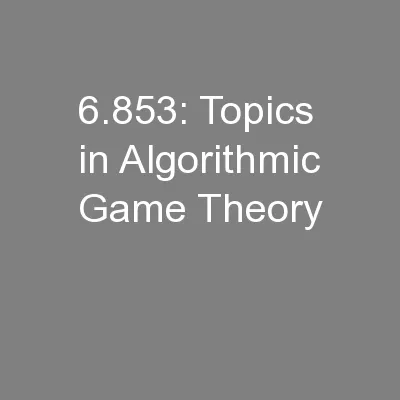

Fall 2011 Constantinos Daskalakis Lecture 16 Recap Exchange Market Model traders divisible goods trader i has endowment of goods nonnegative reals amount of goods trader comes to the marketplace with ID: 395181
Download Presentation The PPT/PDF document "6.853: Topics in Algorithmic Game Theory" is the property of its rightful owner. Permission is granted to download and print the materials on this web site for personal, non-commercial use only, and to display it on your personal computer provided you do not modify the materials and that you retain all copyright notices contained in the materials. By downloading content from our website, you accept the terms of this agreement.
Slide1
6.853: Topics in Algorithmic Game Theory
Fall 2011
Constantinos Daskalakis
Lecture 16Slide2
RecapSlide3
Exchange Market Model
traders
divisible goods
trader
i
has:
- endowment of goods
non-negative
reals
amount of goods trader comes to the marketplace with
consumption set for trader
i
specifies trader
i
’s
utility for bundles of goods
- utility
functionSlide4
Competitive (or Walrasian
) Market Equilibrium
total demand
total supply
Def:
A price vector is called a
competitive market equilibrium
iff
there exists a collection of optimal bundles of goods, for all traders
i
= 1,…,
n
, such that the total supply meets the total demand, i.e.
[ For Fisher Markets: ]Slide5
Arrow-Debreu Theorem 1954
Theorem [Arrow-Debreu 1954]: Suppose
Then a competitive market equilibrium exists.
(
i
) is closed and convex
(iii a)
(iii
b
)
(iii
c
)
(ii) (all coordinates positive) Slide6
Gross-Substitutability ConditionSlide7
Excess Demand at prices p
We already argued that under the Arrow-Debreu
Thm
conditions:
(H)
f
is homogeneous, i.e.
(WL)
f
satisfies
Walras’s
Law, i.e.
(we argued that the last property is true using
nonsatiation
+ quasi-concavity, see next slie)
suppose there is a unique demand at a given price vector
p
and its is continuous (see last lecture)Slide8
Excess Demand at prices p
We already argued that under the Arrow-Debreu
Thm
conditions:
(H)
f
is homogeneous, i.e.
(WL)
f
satisfies
Walras’s
Law, i.e.
suppose there is a unique demand at a given price vector
p
and its is continuous (see last lecture)Slide9
Gross-Substitutability (GS)
Def: The excess demand function satisfies Gross Substitutability
iff for all pairs of price vectors p and
p
’
:
In other words, if the prices of some goods are increased while the prices of some other goods are held fixed, this can only cause an increase in the demand of the goods whose price stayed fixed. Slide10
Differential Form of Gross-Substitutability (GSD
)
Def: The excess demand function satisfies the Differential Form of Gross Substitutability
iff
for all
r
,
s
the partial derivatives exist and are continuous, and for all
p
:
Clearly:
(GS
D
) (GS)Slide11
Not all goods are free (Pos)
Def: The excess demand function satisfies (Pos) if not all goods are free at equilibrium. I.e. there exists at least one good in which at least one trader is interested. Slide12
Weak Axiom of Revealed Preferences (WARP)
Theorem [Arrow
-Block-Hurwicz 1959]:
Proof on the board
Suppose that the excess demand function of an exchange economy satisfies (H), (WL), and (GS). If >0 is any equilibrium price vector and >0 is any non-equilibrium vector we haveSlide13
Computation of Equilibria
Corollary 1 (of WARP)
: If the excess demand function satisfies (H), (WL), and (GS), it can be computed efficiently and is Lipschitz, then a positive equilibrium price vector (if it exists) can be computed efficiently.
proof sketch
: W.
l
.
o
.
g
. we can restrict our search space to price vectors in [0,1]
k
, since any equilibrium can be rescaled to lie in this set (by homogeneity of the excess demand function). We can then run ellipsoid, using the separation oracle provided by the weak axiom of revealed preferences. In particular, for any non-equilibrium price vector
p, we know that the price equilibrium lies in the half-spaceSlide14
Tatonnement
Corollary 2
: If the excess demand function satisfies continuity, (H), (WL), (GSD), and (Pos), then the
tatonnement
process (price-adjustment mechanism) described by the following differential equation converges to a market equilibrium
To show convergence to a price equilibrium, let us pick
an arbitrary
price equilibrium vector
on the equilibrium ray (Lemma 2) and
consider the following potential function
proof sketch
: Because of continuity, the above system has a solution. Moreover, because of the initial condition, it can be shown (…) that the solution stays positive, for all
t
, and remains within the box B=[min p(0) , max p(0)]
k
.Slide15
[Properties of Equilibrium
Lemma 1
[Arrow-Block-Hurwicz 1959]:
Suppose that the excess demand function of an exchange economy satisfies (H), (GS
D
) and (Pos). Then if is an equilibrium price vector
Call this property (E
+
)
Lemma 2
[Arrow-Block-
Hurwicz
1959]:
Suppose that the excess demand function of an exchange economy satisfies (H), (GS) and (E
+
). Then if and are equilibrium price vectors, there exists such that
i.e. we have uniqueness of the equilibrium
ray]Slide16
Corollaries
proof sketch (cont): We have
Observe that if, for some t
0
, p
(
t
0
) is a price equilibrium vector, then
(by lemma 1)
On the other hand, as long as
p
(
t
) is not an equilibrium, WARP implies that
implying that the L2 distance from is monotonically decreasing for all
t
. Slide17
Corollaries
proof sketch (cont):
On the other hand, as long as
p
(
t
) is not an equilibrium, WARP implies that
implying that the L2 distance from is monotonically decreasing for all
t
.
To show convergence to a price equilibrium vector, assume for a contradiction that the
p
(
t
) stays at distance from the equilibrium ray for all
t.
The continuity of and compactness of B can be used to show that in this case the absolute value of remains bounded away from 0. This leads to a contradiction since
V(t
) ≥0.